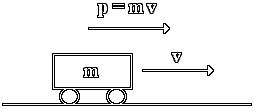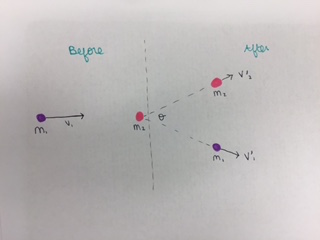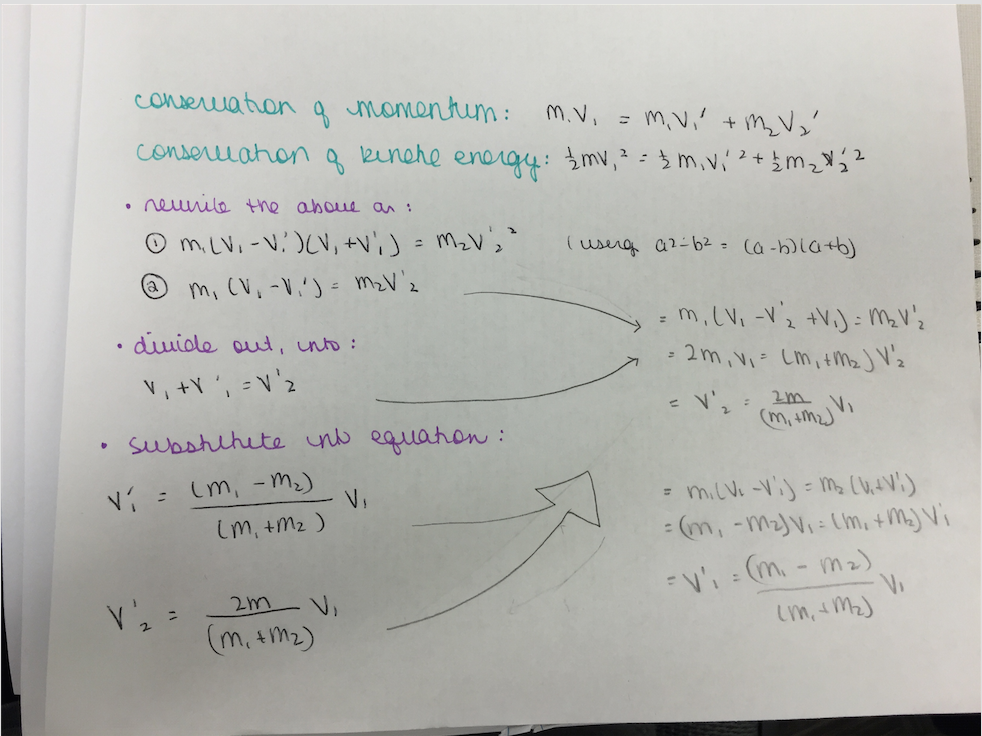Newton's Laws and Linear Momentum
Edited by Lakshmi Krishnan, 4/8/17
Linear Momentum
Linear momentum, denoted by the letter p, is a vector quantity which represents the product of an object's velocity, v, and mass, m, as it moves along a straight line. As a vector quantity, an object's linear momentum possesses momentum and direction and is therefore always in the same direction as its velocity vector. Linear momentum can be expressed by the equation: p = mv
When an object is moving, it has a non-zero momentum. If an object is standing still, then its momentum is zero.
By Newton's Second Law, F=ma, the conservation of linear momentum is supported. Since acceleration can be expressed as ∆v/∆t, Newton's Second Law could therefore be expressed as F = m∆v/∆t. Since m∆v is equal to momentum, p, an expression of Newton's Second Law can be expressed in terms of momentum as F=∆p/∆t. In many ways, this expression of Newton's Second Law is more versatile than the equation F=ma, because it can be used to analyze systems where the velocity changes and the mass of a body changes. For instance, it can be applied to a motorcycle burning fuel by taking in to account not only the velocity change, but also the change in the mass of the body, which in this case would be the fuel burning and thus lowering the total body mass of the motorcycle.
Newton's laws of motion also play a role in supporting the law of conservation of linear momentum. Linear momentum is a conserved quantity, and therefore in a closed system (a system that does not allow transfers of mass or energy into or out of the system), the total momentum of the system will not change. This allows one to calculate and predict the outcomes when objects bounce into one another. Or, by knowing the outcome of a collision, one can reason what was the initial state of the system.
Real World Examples
Newton’s 3rd Law:
Scenario: There is a car that is stuck, nestled in the trees. Woman appears healthy and stable.
Witness Statement: Witness says that as a car was making a turn, the car “somehow lost its balance and skid”, deviating off its regular path, and ended up sliding towards the trees, around 30 metres from where she was. The witness claims the car was travelling at 25 miles per hour.
Report: This is a classic combination case of NEWTON’S 1st and 3rd LAW. The first law says that objects at a fixed velocity will stay at that velocity unless acted upon by an unbalanced, external force. It is worth pointing out that when the car was skidding, it was displaying inertia, or the tendency to resist a change in motion. In the car, as the wheels go around, it’s static friction. The force that is pushing the car along the road is a friction force... we need to the road to move the car, cause the road provides the friction. This is Newton’s 3rd Law. The tires are pushing backwards on the road, and the road is pushing forward on the tires. This “push force” is what we’re relying on keep the car on the road, so essentially, we’re relying on this static friction force. When the car starts to skid, it changes to force of kinetic friction, because the wheels are now slipping and having some motion. It slides and is moving, so it becomes kinetic friction.
The witness claimed that the car was going at 25 miles per hour. With this being said, an official wanted check and make sure this really was the speed. Since the car is now 30 metres from the place it lost its balance, we can use this information to calculate the speed. Assuming the brakes work properly, the stopping distance would’ve been determined by the coefficient of friction between the tires and the road. This is because the force of friction must do enough work on the car to reduce the kinetic energy of the car, as outlined in the work-energy principle. Net Work = change in kinetic energy of an object Net Work = (1/2)mv(final)^2 - (1/2)mv(initial)^2 When we look at the equation for static friction: Ms = Ff / Fn Fn x Ms = Ff Ms x mg = Fr Mu static x mg = Force of friction Since the road was a bit slippery, and the road a little wet, the coefficient of static friction was 0.4. The normal coefficient is around 0.7 for dry roads and becomes smaller for wet or oily roads. Gravity was 10, so the equation would’ve been:
Work Friction = -μmgd = - (1/2) mv^2
If we cancel out the m’s, we can get D = (v^2) / (2)(μ)(g) Plugging in what we have and what we know: 30 = (V^2) / 2 x .4 x 10 30 = (V^2) / 8 V = 15 metre / second, so around 35 miles per hour. The witness’ account of the speed was a little off!
Conclusion: Like most skids, as soon as this car started to skid, it was at the mercy of inertia. It would keep going at the same speed unless some other force stopped it, and in this case, that “other force” was the tress.
Newton’s 2nd Law:
Scenario: A lady has hit a lamppost. She appears fine, but the car has been totalled.
Witness Statement: As a lady cruised by in her Honda Civic, she momentarily took her eyes off the road, and found her car in front of a lamppost and crashed into it.
Report: This case is a Newton’s 2nd law case, and impluse. According to the law, F = MA, which means that F = M x (ΔV / ΔT), or F = M((Vf -Vi) / T) F ΔT = M(Vf - Vi) The extent of her injury is determined by the force that hit her. So, the size of the force she’s subjected to is determined by the interaction time. If the T becomes smaller, the force is bigger; if T is bigger, the force gets smaller. The sudden change of velocity also played a part in her injury. The car should’ve had safety features that made the interaction time as long as possible, because if you can spread the reaction time, you can do the deceleration with a smaller force - We can reduce the size of the force if we reduce the time.
One must also look at the impact force this car has faced. A crash like this one, that stops the car completely, must take away all the kinetic energy of the car, and as highlighted by the work-energy principle, it would take a longer stopping distance to decrease the impact force.
Net Work = (1/2)mv(final)^2 - (1/2)mv(initial)^2 The change in the kinetic energy of an object is equal to the net work done on the object.
The car is noted to be 1600 kgs, or 16,000 N, and travelling at a speed of 10 m/s. The work required by the lamppost to stop the car would be F(avg)D = -(1/2)mv^2 What would be the force on the car?
Mass = Weight/ Acceleration of Gravity Mass = 16,000 N / 10 (M/S^2) Mass = 1600 kgs
KE = (1/2)mv^2 KE = (1/2)x1600x(10m/s)^2 = 80000 Joules = kg x m^2 / s^2
d=1 metre, or 3 feet after impact
F(avg) = KE / d
80000 / 1 = 80,000 newtons, or 8.96 tons!
Conclusion: Thus, the “crumple zones” in the front of the car, and the airbags came in handy, because rather than allowing sudden stop, the car was allowed to halt over a larger period of time, making the force less than it would’ve been without them. Thanks, impulse!
Inertia / Newton’s 1st Law:
Scenario: At a stop light, a car halts and waits for a green. However, the car behind it doesn’t stop in time, and bumps the in front of it, from the behind. A lady in the car, who has just been in a car accident, is complaining of severe neck pain
Report: This has almost everything to do with law of inertia, or Newton’s 1st Law. In Newton’s first law, he states that an object at rest stays at rest, or an object in motion will stay in motion, unless acted upon by an unbalanced force. That is, if an object (be it a head, moving at a certain velocity because of the car) will tend to stay at the same speed and in the same direction, unless something stops it. Back to the scenario: In a way, it’s a good things this lady was wearing a seatbelt... it slows down the inertia. For example, if a kid was in the car, and was NOT wearing a seatbelt, people would think that the kid launched forward. Really, it’s just that the car is brought to a halt, but the kid just continues at their original velocity. This is inertia in action -- that is, the tendency to resist change in the state of motion they are already in. However, in this case, the seatbelt was (kind of!) bad, as it caused the overextension of head. The head weighs around 4-5 kilos, and we know that when car comes to a sudden halt, body is stopped, skull continues on, it’s called whiplash. In this case, when the person bumped into the other car from behind... your car is stunned forward, body with it... head is stationary, is remaining in the same, position, the lady’s car’s inertia wants to stay where it was originally. The body was moved, but the head wanted to stay in its original velocity, but followed the body in the seconds after.
Conclusion: If the lady complains of any neck pain, it’s probably because of inertia, and the possibility that the lady has overextended her neck beyond elastic limits. She will be wearing a neck brace if this is the case!
Elastic Collision:
Scenario: A woman is lying on the side of the road, appears to have been hit by a car.
Witness Statement: Witness says that there was a lady walking across the road and at the middle of the road, she paused for a second because she saw a car coming at her. The car was unable to stop in time, and hit the lady at a speed of 25 miles per hour, or around 10 metres per second. The witness also notes the layer of ice on the road.
Report: This is an example of the Law of Conservation of Momentum, which states that in the absence of an external force, there is conserved quantity of momentum, or
P initial = P final (where P = momentum)
MOMENTUM = M X V M1V1 + M2V2= M1U1 + M2U2 (M = mass , V1 and V2 = initial velocity of object 1 and 2, U1 and U2 = velocities after collision Essentially, the momentum that was lost by the car, is equal to the momentum gained by the lady. The lady would’ve had no velocity when the car hit her, and according to the law of conservation of momentum - whatever momentum you have at the start, you have at the end. This means that there would’ve been a redistribution of momentum between car and lady. The car will give some momentum to the lady... however, the car can’t give mass, so the only thing it can her give is velocity.
If we investigate further, we can see that this system was an isolated system. Normally, in collisions like these, we are not dealing with isolated systems... because that would mean that force is free from the influence of a net external force, or a force that can alter the momentum. Most of the time, friction between the car and the road, being an external force, would contribute to a change in total momentum. However, after observing the road, we can say that conditions were such that any external force (ie. friction and air resistance) was negligible, and thus, the total momentum of the two particles are conserved.
What we see here is a case of elastic collision - which means that there was no loss of kinetic energy. In an elastic collision, the objects “bounce” off each other, and don’t stick together to become one body - because this would be an inelastic collision, where part of the kinetic energy is changed to some other form of energy in the collision. But, as said before, this was an elastic collision, it would’ve looked something like this:
It was noted that the car weighed 1600 kgs, while the woman weighs 50 kgs. The speed of the car was 10 metres/second, while the women's speed was 0 m/s (she stood still) We can figure out the velocities of both the woman and and the cars after the collision by deriving the formula
Velocities after the collision
V1 =[ M1 - M2 / (M1+ M2) ] V V2 = [ 2M1/ M1 + M2 ] V
- Conclusion: If we make a table, we can see the distribution of momentum.
Because of the fact that the mass of the second object (Lady) is much smaller compared to the mass of the first object (car), the person is thrown back at a relatively high velocity.
Some of the velocity of the bus was given to the lady, which caused her to go flying and land on the other side of the road. This is common of road traffic accident and this redistribution of momentum, in the form of velocity, is where part of her injury comes from.
Resources
https://www.youtube.com/watch?v=gVTOf33UlDA
http://www.physicsclassroom.com/class/momentum/u4l2b.cfm
http://www.physicsclassroom.com/class/newtlaws/Lesson-1/Newton-s-First-Law
http://teachertech.rice.edu/Participants/louviere/Newton/law2.html
http://www.physicsclassroom.com/class/newtlaws/Lesson-3/Newton-s-Second-Law
http://www.physicsclassroom.com/class/newtlaws/Lesson-1/Inertia-and-Mass
http://www.physicsclassroom.com/mmedia/energy/cs.cfm
http://hyperphysics.phy-astr.gsu.edu/hbase/elacol2.html#c1
http://www.physicsclassroom.com/class/momentum/u4l2b.cfm
http://www.laserpablo.com/teacherresources/files/APLabs_CCPhysics/10-Billiard_Ball_Physics.pdf
http://hyperphysics.phy-astr.gsu.edu/hbase/inecol.html#c1
http://hyperphysics.phy-astr.gsu.edu/hbase/impulse.html#c1
http://hyperphysics.phy-astr.gsu.edu/hbase/seatb.html#cc1
http://hyperphysics.phy-astr.gsu.edu/hbase/work.html#wepr



